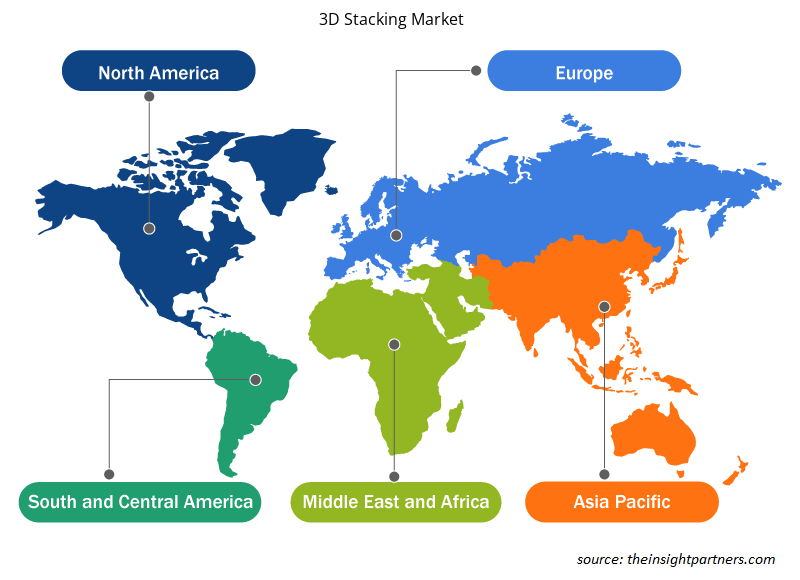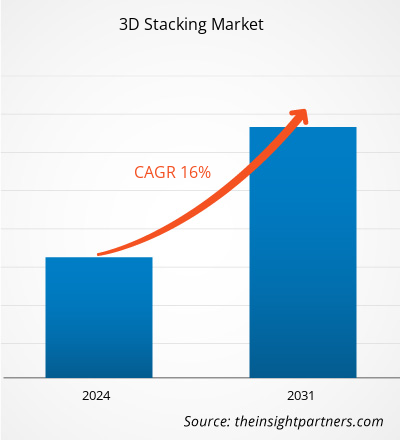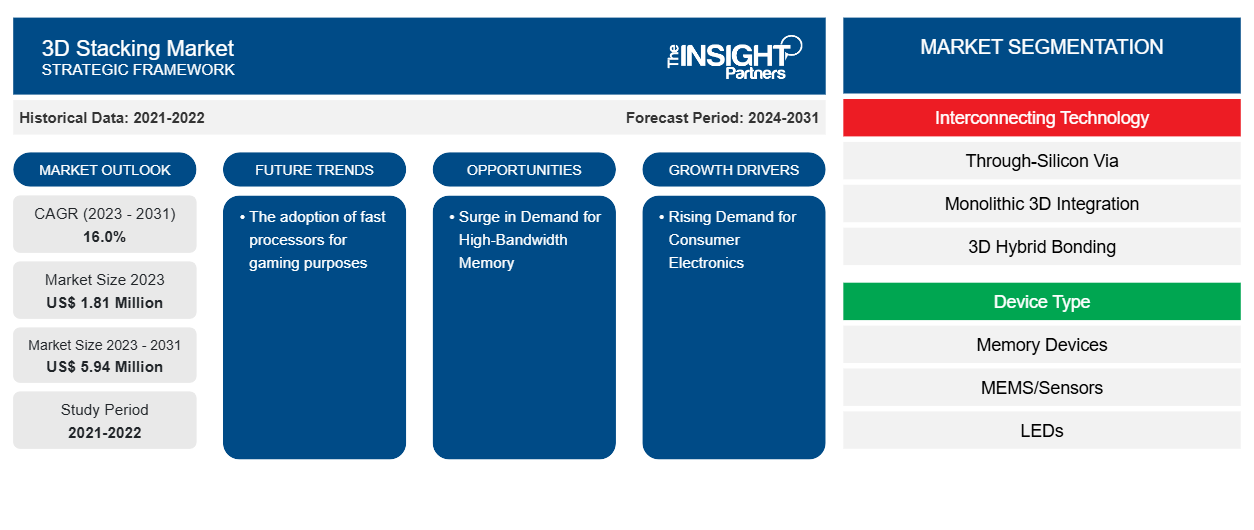3D 스태킹 시장 규모는 2023년 18억 1,000만 달러에서 2031년 59억 4,000만 달러로 증가할 것으로 예상됩니다. 이 시장은 2023년부터 2031년까지 16.0%의 CAGR을 기록할 것으로 추산됩니다. 게임 목적으로 고속 프로세서를 도입하는 것은 주요 시장 추세로 남을 가능성이 높습니다.
3D 스태킹 시장 분석
3D 적층 구성 내에서 더 짧은 상호 연결은 전력 소모를 줄이고 신호 무결성을 개선하여 에너지 효율적이고 고성능 애플리케이션에 매력적인 솔루션이 됩니다. 3D 적층 기술의 채택이 증가하는 것은 3D 적층 시장 성장에 기여하는 핵심 요인입니다. 이 기술은 기판에 다이를 적층하여 더 작고 에너지 효율적인 패키지로 칩을 만들 수 있습니다. 또한 3D 적층 기술은 특히 가전 제품 분야에서 혁신적이고 기능이 풍부한 제품의 개발을 용이하게 합니다. 메모리와 로직 구성 요소를 수직으로 적층할 수 있는 기능을 통해 더욱 강력하고 컴팩트한 장치를 만들 수 있으며, 이는 세련되고 고성능 가젯에 대한 시장 수요에 부합합니다.
3D 스태킹 시장 개요
3D 스태킹 기술은 반도체 패키징 분야에서 혁신적인 발전을 나타내며 전자 부품이 통합되고 상호 연결되는 방식에 패러다임 전환을 제공합니다. 이 최첨단 기술은 일반적으로 TSV(실리콘 관통 비아)를 사용하여 여러 개의 집적 회로(IC) 층을 수직으로 스태킹하는 것을 포함합니다. 3D 스태킹 기술은 다양한 산업에서 제품 설계와 성능을 혁신하여 더 컴팩트한 폼 팩터에서 우수한 기능을 달성할 수 있는 잠재력을 가지고 있습니다. 또한 이 기술은 기업이 기술 혁신의 최전선에 서서 빠르게 진화하는 전자 장치 및 반도체 솔루션 분야에서 경쟁 우위를 확보할 수 있도록 지원합니다. 3D 스태킹 기술은 메모리, 로직, 센서와 같은 이질적인 구성 요소를 단일 패키지로 효율적으로 통합하여 성능을 향상시키고 설치 공간을 줄일 수 있습니다. 이 기술은 간소화된 제조 프로세스, 최적화된 공급망 관리 및 비용 절감에 도움이 됩니다.
귀하의 요구 사항에 맞게 이 보고서를 사용자 정의하세요
이 보고서의 일부 또는 국가 수준 분석, Excel 데이터 팩을 포함하여 모든 보고서에 대한 사용자 정의를 무료로 받을 수 있으며 신생 기업 및 대학을 위한 훌륭한 혜택과 할인 혜택을 이용할 수 있습니다.
-
이 보고서의 주요 시장 동향을 알아보세요.이 무료 샘플에는 시장 동향부터 추정 및 예측까지 다양한 데이터 분석이 포함됩니다.
3D 스태킹 시장 동인 및 기회
소비자 전자 제품에 대한 수요 증가로 시장이 호조
스마트폰, 태블릿, 스마트워치, 휴대용 기기와 같은 세련되고 기능이 풍부하며 전력 효율적인 가젯에 대한 수요가 급증함에 따라 제조업체는 소형 고성능 솔루션을 제공해야 하는 엄청난 압력을 받고 있습니다. 예를 들어, 2024년 2월에 발표된 Omdia 데이터에 따르면 2023년 4분기 스마트폰 의 예비 출하량은 3억 2,800만 대였습니다. 이는 4Q22 대비 8.6% 증가한 수치로, 4Q23은 2Q21 이후 처음으로 큰 성장을 보인 분기가 되었습니다. 전 세계 소비자는 쇼핑, 커뮤니케이션, 엔터테인먼트 및 기타 용도로 스마트폰을 적극적으로 채택하고 있습니다. 이러한 기기는 3D 적층 다이 패키징을 사용하여 디자인과 기능에 혁신을 일으키고 있습니다. 3D 적층 다이 패키징은 성능을 저하시키지 않고도 폼 팩터를 크게 줄일 수 있습니다. 이 기술은 여러 층의 집적 회로를 수직으로 적층함으로써 소형 공간 내에서 다양한 구성 요소를 원활하게 통합할 수 있습니다. 이러한 통합은 설계 및 조립 공정을 간소화할 뿐만 아니라, 제조업체가 소비자의 변화하는 선호도에 맞춰 얇고 더욱 미적으로 매력적인 장치를 개발할 수 있도록 해줍니다.
고대역폭 메모리 수요 급증
수많은 DRAM(Dynamic Random Access Memory)을 수직으로 쌓아 매우 높은 밀도에 도달하는 고대역폭 메모리(HBM)는 빠른 데이터 처리와 낮은 전력 소모가 특징입니다. 이는 생성형 AI와 같이 엄청난 양의 데이터를 상당히 빠른 속도로 처리해야 하는 고성능 컴퓨팅(HPC)에 필수적입니다. 삼성전자의 12단 적층 HBM은 차세대 3D 스태킹 패키징 기술을 사용하여 성능과 수율을 높였습니다. 처리 속도가 6.4Gbps이고 대역폭이 819GB/s인 HBM3는 이전 세대 DRAM보다 1.8배 빠르면서도 전력을 10% 적게 사용합니다. 고성능 컴퓨팅 애플리케이션에서 HBM에 대한 수요는 시장 참여자들이 생산을 늘리도록 장려합니다. 예를 들어, SK하이닉스는 2024년 3월에 초고성능을 갖춘 최신 AI 메모리 제품인 HBM3E1의 양산을 시작했습니다. HBM3E는 엄청난 양의 데이터를 빠르게 처리하는 AI 시스템을 위해 설계되었습니다. 고대역폭 메모리는 통신, 자동차, 의료, 제조 등 다양한 산업에서 고속 데이터 처리를 위해 사용됩니다.
3D 스태킹 시장 보고서 세분화 분석
3D 스태킹 시장 분석에 기여한 주요 부문은 기술, 장치 유형, 최종 사용자입니다.
- 기술에 따라 3D 스태킹 시장은 실리콘 관통 비아, 모노리식 3D 통합, 3D 하이브리드 본딩으로 세분화됩니다. 실리콘 관통 비아 세그먼트는 2023년에 더 큰 시장 점유율을 차지했습니다.
- 장치 유형에 따라 3D 스태킹 시장은 메모리 장치, MEMS/센서, LED, 이미징 및 광전자 및 기타로 세분화됩니다. 메모리 장치 세그먼트는 2023년에 시장을 지배했습니다.
- 최종 사용자 측면에서 3D 스태킹 시장은 가전제품, 통신, 자동차, 제조, 의료 및 기타로 세분화됩니다. 가전제품 부문은 2023년에 시장을 지배했습니다.
지역별 3D 스태킹 시장 점유율 분석
- 3D 스태킹 시장은 북미, 유럽, 아시아 태평양(APAC), 중동 및 아프리카(MEA), 남미 및 중미의 5개 주요 지역으로 구분됩니다. 아시아 태평양이 2023년 시장을 지배했고, 그 뒤를 북미와 유럽이 이었습니다.
- 아시아 태평양 지역의 3D 스태킹 시장 성장은 반도체 제조 및 가전제품에 대한 수요 증가에 기인합니다. 아시아 태평양 재단에 따르면 중국과 대만은 칩 제조에 대한 투자를 크게 늘렸으며, 이는 한국과 일본에도 이익이 될 것으로 예상됩니다. 또한 대만 반도체 제조 회사는 일본에 첫 번째 공장을 설립할 계획이었는데, 이는 국내 공급망을 더욱 확대하기 위해 반도체 제조를 우선시한다는 일본 총리의 의제와 일치했습니다. 게다가 반도체 제조 및 가전제품 산업의 확대는 예측 기간 동안 시장 성장에 수익성 있는 기회를 창출할 것으로 예상됩니다.
3D 스태킹 시장 지역 통찰력
Insight Partners의 분석가들은 예측 기간 동안 3D 스태킹 시장에 영향을 미치는 지역적 추세와 요인을 철저히 설명했습니다. 이 섹션에서는 북미, 유럽, 아시아 태평양, 중동 및 아프리카, 남미 및 중미의 3D 스태킹 시장 세그먼트와 지리적 분포도 설명합니다.

- 3D 스태킹 시장에 대한 지역별 데이터 얻기
3D 스태킹 시장 보고서 범위
| 보고서 속성 | 세부 |
|---|---|
| 2023년 시장 규모 | 181만 달러 |
| 2031년까지 시장 규모 | 594만 달러 |
| 글로벌 CAGR (2023-2031) | 16.0% |
| 역사적 데이터 | 2021-2022 |
| 예측 기간 | 2024-2031 |
| 다루는 세그먼트 |
상호 연결 기술로
|
| 포함된 지역 및 국가 |
북아메리카
|
| 시장 선도 기업 및 주요 회사 프로필 |
|
3D 스태킹 시장 플레이어 밀도: 비즈니스 역학에 미치는 영향 이해
3D 스태킹 시장 시장은 소비자 선호도의 변화, 기술 발전, 제품의 이점에 대한 인식 증가와 같은 요인으로 인해 최종 사용자 수요가 증가함에 따라 빠르게 성장하고 있습니다. 수요가 증가함에 따라 기업은 제품을 확장하고, 소비자의 요구를 충족하기 위해 혁신하고, 새로운 트렌드를 활용하여 시장 성장을 더욱 촉진하고 있습니다.
시장 참여자 밀도는 특정 시장이나 산업 내에서 운영되는 회사나 기업의 분포를 말합니다. 주어진 시장 공간에 얼마나 많은 경쟁자(시장 참여자)가 존재하는지 그 규모나 총 시장 가치에 비해 나타냅니다.
3D 스태킹 시장에서 운영되는 주요 회사는 다음과 같습니다.
- 대만 반도체 제조 회사 유한회사
- 인텔 주식회사
- 어드밴스드 마이크로 디바이스
- 브로드컴 주식회사
- NXP 반도체
- ASE 기술
면책 조항 : 위에 나열된 회사는 어떤 특별한 순서에 따라 순위가 매겨지지 않았습니다.

- 3D 스태킹 시장의 주요 주요 업체 개요를 알아보세요
3D 스태킹 시장 뉴스 및 최근 개발
3D 스태킹 시장은 1차 및 2차 조사 이후의 정성적, 정량적 데이터를 수집하여 평가합니다. 여기에는 중요한 기업 간행물, 협회 데이터 및 데이터베이스가 포함됩니다. 3D 스태킹 시장의 몇 가지 개발 사항은 다음과 같습니다.
- 인텔 연구원들은 2023 IEEE 국제 전자소자 회의(IEDM)에서 후면 전력 및 직접 후면 접점과 결합된 3D 적층 보완 금속 산화물 반도체(CMOS) 트랜지스터의 발전을 선보였습니다. 이 회사는 또한 후면 접점과 같은 후면 전력 공급을 위한 최근 R&D 혁신에 대한 확장 경로에 대해 보고했으며, 패키지가 아닌 동일한 300mm 웨이퍼에 실리콘 트랜지스터와 질화갈륨(GaN) 트랜지스터의 대규모 3D 모놀리식 통합을 성공적으로 시연했습니다. (출처: Intel Corp, 보도자료, 2023년 12월)
3D 스태킹 시장 보고서 범위 및 제공물
"3D 스태킹 시장 규모 및 예측(2021-2031)"은 아래에 언급된 영역을 포괄하는 시장에 대한 자세한 분석을 제공합니다.
- 범위에 포함된 모든 주요 시장 세그먼트에 대한 글로벌, 지역 및 국가 수준의 3D 스태킹 시장 규모 및 예측
- 3D 스태킹 시장 동향과 드라이버, 제약 및 주요 기회와 같은 시장 역학
- 자세한 PEST/포터의 5가지 힘과 SWOT 분석
- 주요 시장 동향, 글로벌 및 지역 프레임워크, 주요 업체, 규정 및 최근 시장 개발 사항을 포괄하는 3D 스태킹 시장 분석
- 3D 스태킹 시장의 시장 집중도, 히트맵 분석, 유명 업체 및 최근 개발 사항을 다루는 산업 환경 및 경쟁 분석
- 자세한 회사 프로필
- 과거 분석(2년), 기준 연도, CAGR을 포함한 예측(7년)
- PEST 및 SWOT 분석
- 시장 규모 가치/거래량 - 글로벌, 지역, 국가
- 산업 및 경쟁 환경
- Excel 데이터세트
최근 보고서
관련 보고서
사용 후기
구매 이유
- 정보에 기반한 의사 결정
- 시장 역학 이해
- 경쟁 분석
- 고객 인사이트
- 시장 예측
- 위험 완화
- 전략 기획
- 투자 타당성 분석
- 신흥 시장 파악
- 마케팅 전략 강화
- 운영 효율성 향상
- 규제 동향에 발맞춰 대응























 무료 샘플 받기 - 3D 스태킹 마켓
무료 샘플 받기 - 3D 스태킹 마켓